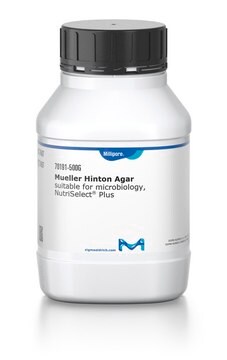A6686
Agar
Bacteriological, microbiology tested, suitable for plant cell culture, granular
Synonym(s):
Agar-agar, Gum agar
About This Item
Recommended Products
biological source
algae (Rhodophyceae)
Quality Level
form
granular
technique(s)
cell culture | plant: suitable
mp
83-89 °C
transition temp
transition temp 32-39 °C
suitability
microbiology tested
application(s)
agriculture
storage temp.
room temp
InChI
1S/C14H24O9/c1-5-8(16)13-11(7(21-5)4-20-13)23-14-10(18)12(19-2)9(17)6(3-15)22-14/h5-18H,3-4H2,1-2H3/t5?,6-,7?,8-,9+,10-,11?,12+,13+,14?/m1/s1
InChI key
GYYDPBCUIJTIBM-DYOGSRDZSA-N
Looking for similar products? Visit Product Comparison Guide
General description
Application
- to culture Staphylococcus aureus for phage infection studies
- as a supplement with NZCYM media for culturing Campylobacter coli strains for lysogeny screening
- as a basic media component to improve in vitro ovule and embryo culture methods of cross Chitalpa hybrids to facilitate the rescue of triploids
- in the culture media for Bdellovibrio spp. and Micavibrio spp. strains to check their susceptibility towards a variety of select agents
Other Notes
Storage Class Code
11 - Combustible Solids
WGK
WGK 1
Personal Protective Equipment
Certificates of Analysis (COA)
Search for Certificates of Analysis (COA) by entering the products Lot/Batch Number. Lot and Batch Numbers can be found on a product’s label following the words ‘Lot’ or ‘Batch’.
Already Own This Product?
Find documentation for the products that you have recently purchased in the Document Library.
Customers Also Viewed
Our team of scientists has experience in all areas of research including Life Science, Material Science, Chemical Synthesis, Chromatography, Analytical and many others.
Contact Technical Service


